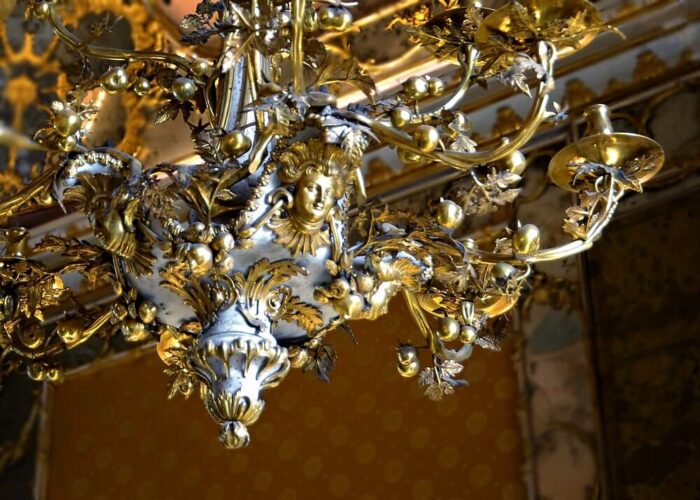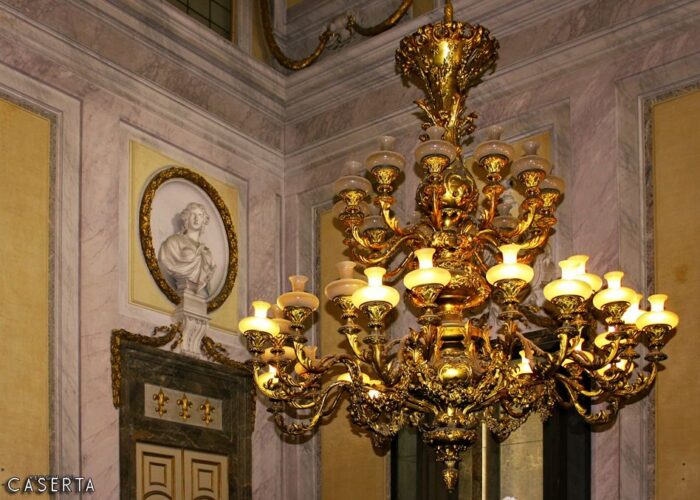The chandelier
The evolution of the chandelier from the 18th to the 19th century.
Introduction to chandelier
A palace furniture, or a chandelier, is usually defined as having a “baroque” style. Often we mean by baroque anything that has a very luxurious and decorated look, but looking more carefully we notice that they have different styles.
Due to its history and its vicissitudes, the Royal Palace of Caserta gives the visitor the extraordinary opportunity to discover the differences and the evolution of taste from the late Baroque style to the nineteenth-century revival.
To know the elements that distinguish each style
Chandelier: BAROQUE / LOUIS Xiv - (1600? -1720?)
Wooden chandelier
Chandelier of the Palatine Chapel
Features
Baroque chandelier in gilded wood with acanthus leaves decorations and flowers in the upper part. it is substantially baroque despite the typical Rococo plant elements.
Curiosity
it is completely made of carved wood
ROCOCÒ / Louis XV - (1700? -1770?)
Chandelier with tomatoes
Features
Being decorated with intertwining branches and leaves and with tomatoes, therefore with vegetable elements, is typical of the Rococo era, as a greater relaxation and return to nature was sought, in place of symmetry and absolute control typical of Louis XIV era. Find out more about this chandelier
Curiosity
The decorations are made of gilded copper
Murano chandelier
Features
This typically Venetian chandelier is decorated with flowers and other typically Rococo plant elements, in the first half of the 18th century a greater relaxation and return to nature was sought, in place of the symmetry and absolute control typical of the Louis XIV era.
Curiosity
On the arms it was possible to insert decorative pendants as desired, exactly as is done today with the “charms” in bracelets.
Chandelier: NEOCLASSICAL / LOUIS XVI - (1770? -1804?)
Chandelier in cut crystal
Features
The basic shape is still the Rococo one, but the appearance is very linear and without floral elements. The decorative elements are of geometric shape and cut crystal.
Curiosity
Neoclassical chandeliers, using crystal instead of glass, are much heavier. In fact, in the crystal there is always a part of lead in the mixture.
EMPIRE (Late Neoclassical) - (1804-1840)
Empire chandelier
Features
Typical Napoleon Empire style chandelier. Note the round and elongated crystal elements derived from the neoclassical equivalent. The basic structure resembles that of the oil lamp mentioned above.
Curiosity
The gilded bronze structure and the lead crystal elements make this kind of chandeliers extremely heavy
ViCTORIAN AGE REVIVALS - (1840-1900)
Neo-Baroque chandelier
Features
Neo-Baroque style. Despite the massive appearance typical of the style, it has the typical Rococo naturalistic decorations, the festoons in the lower part of the neoclassical era. The mix of different styles is typical of the 19th century, and the final appearance is more striking than a Louis XIV equivalent.
Curiosity
They were added after the unification of Italy most likely to replace other ancient ones taken away
Neo-Baroque chandelier
Features
The central twisted support is Baroque, the arms Rococò, the central part has a neoclassical band with repeated motifs and acanthus leaves, while at the top there is a zoomorphic decoration.
Curiosity
The twisted column is typically Baroque, and recalls, for example, that of the canopy of St. Peter’s Basilica in Rome, by Bernini.
Neo-Gothic pendant lamp
Features
Neo-Gothic style in silver and gilt silver. The nineteenth-century dating is evident above all in the upper part, where you can see the stylized palm trees of the Empire style, the applications in the shape of the Rococò letter “S”. A medieval object cannot have 18th century decorations, so it is from the Victorian era.
Curiosity
Among the many fashions of the past, there was also that for medieval gothic, but softened according to the taste of the time
External Link











